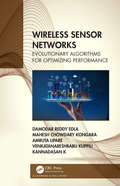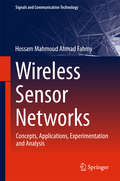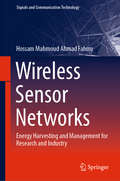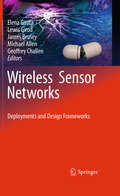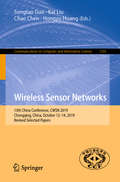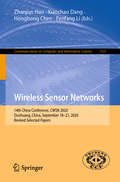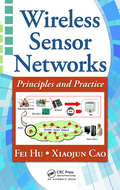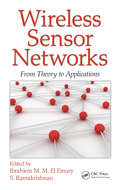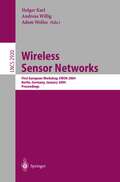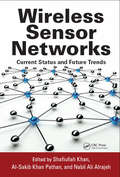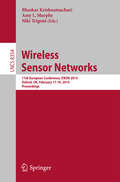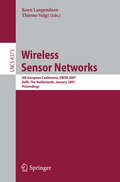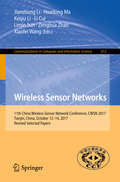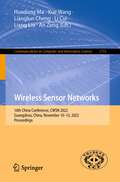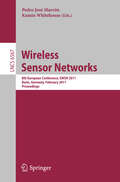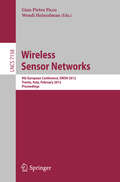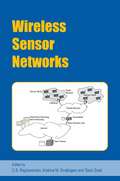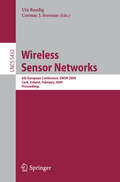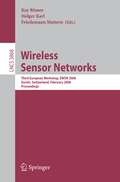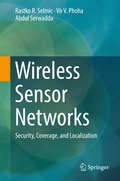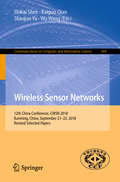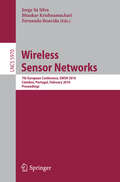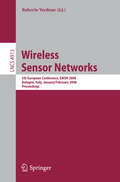- Table View
- List View
Wireless Sensor Networks: Evolutionary Algorithms for Optimizing Performance
by Damodar Reddy Edla Mahesh Chowdary Kongara Amruta Lipare Venkatanareshbabu Kuppili Kannadasan KWireless Sensor Networks: Evolutionary Algorithms for Optimizing Performance provides an integrative overview of bio-inspired algorithms and their applications in the area of Wireless Sensor Networks (WSN). Along with the usage of the WSN, the number of risks and challenges occurs while deploying any WSN. Therefore, to defeat these challenges some of the bio-inspired algorithms are applied and discussed in this book. Discussion includes a broad, integrated perspective on various challenges and issues in WSN and also impact of bio-inspired algorithms on the lifetime of the WSN. It creates interdisciplinary theory, concepts, definitions, models and findings involved in WSN and Bio-inspired algorithms making it an essential guide and reference. It includes various WSN examples making the book accessible to a broader interdisciplinary readership. The book offers comprehensive coverage of the most essential topics, including: Evolutionary algorithms Swarm intelligence Hybrid algorithms Energy efficiency in WSN Load balancing of gateways Localization Clustering and routing Designing fitness functions according to the issues in WSN. The book explains about practices of shuffled complex evolution algorithm, shuffled frog leaping algorithm, particle swarm optimization and dolphin swarm optimization to defeat various challenges in WSN. The author elucidates how we must transform our thinking, illuminating the benefits and opportunities offered by bio-inspired approaches to innovation and learning in the area of WSN. This book serves as a reference book for scientific investigators who shows an interest in evolutionary computation and swarm intelligence as well as issues and challenges in WSN.
Wireless Sensor Networks: Evolutionary Algorithms for Optimizing Performance
by Damodar Reddy Edla Mahesh Chowdary Kongara Amruta Lipare Venkatanareshbabu Kuppili Kannadasan KWireless Sensor Networks: Evolutionary Algorithms for Optimizing Performance provides an integrative overview of bio-inspired algorithms and their applications in the area of Wireless Sensor Networks (WSN). Along with the usage of the WSN, the number of risks and challenges occurs while deploying any WSN. Therefore, to defeat these challenges some of the bio-inspired algorithms are applied and discussed in this book. Discussion includes a broad, integrated perspective on various challenges and issues in WSN and also impact of bio-inspired algorithms on the lifetime of the WSN. It creates interdisciplinary theory, concepts, definitions, models and findings involved in WSN and Bio-inspired algorithms making it an essential guide and reference. It includes various WSN examples making the book accessible to a broader interdisciplinary readership. The book offers comprehensive coverage of the most essential topics, including: Evolutionary algorithms Swarm intelligence Hybrid algorithms Energy efficiency in WSN Load balancing of gateways Localization Clustering and routing Designing fitness functions according to the issues in WSN. The book explains about practices of shuffled complex evolution algorithm, shuffled frog leaping algorithm, particle swarm optimization and dolphin swarm optimization to defeat various challenges in WSN. The author elucidates how we must transform our thinking, illuminating the benefits and opportunities offered by bio-inspired approaches to innovation and learning in the area of WSN. This book serves as a reference book for scientific investigators who shows an interest in evolutionary computation and swarm intelligence as well as issues and challenges in WSN.
Wireless Sensor Networks: Concepts, Applications, Experimentation and Analysis (Signals and Communication Technology)
by Hossam Mahmoud FahmyThis book focuses on the principles of wireless sensor networks (WSNs), their applications, and their analysis tools, with meticulous attention paid to definitions and terminology. This book presents the adopted technologies and their manufacturers in detail, making WSNs tangible for the reader. In introductory computer networking books, chapter sequencing follows the bottom-up or top-down architecture of the 7-layer protocol. This book addresses subsequent steps in this process, both horizontally and vertically, thus fostering a clearer and deeper understanding through chapters that elaborate on WSN concepts and issues. With such depth, this book is intended for a wide audience; it is meant to be a helper and motivator for senior undergraduates, postgraduates, researchers, and practitioners. It lays out important concepts and WSN-relate applications; uses appropriate literature to back research and practical issues; and focuses on new trends. Senior undergraduate students can use it to familiarize themselves with conceptual foundations and practical project implementations. For graduate students and researchers, test beds and simulators provide vital insights into analysis methods and tools for WSNs. Lastly, in addition to applications and deployment, practitioners will be able to learn more about WSN manufacturers and components within several platforms and test beds.
Wireless Sensor Networks: Energy Harvesting and Management for Research and Industry (Signals and Communication Technology)
by Hossam Mahmoud FahmyThis second book by the author on WSNs focuses on the concepts of energy, and energy harvesting and management techniques. Definitions and terminologies are made clear without leaning on the relaxing assumption that they are already known or easily reachable, the reader is not to be diverted from the main course. Neatly drawn figures assist in viewing and imagining the offered topics. To make energy related topics felt and seen, the adopted technologies as well as their manufacturers are presented in details. With such a depth, this book is intended for a wide audience, it is meant to be helper and motivator, for the senior undergraduates, postgraduates, researchers, and practitioners; concepts and energy related applications are laid out, research and practical issues are backed by appropriate literature, and new trends are put under focus. For senior undergraduate students, it familiarizes with conceptual foundations and practical projects implementations. Also, it is intended for graduate students working on their thesis and in need of specific knowledge on WSNs and the related energy harvesting and management techniques. Moreover, it is targeting researchers and practitioners interested in features and applications of WSNs, and on the available energy harvesting and management projects and testbeds. Exercises at the end of each chapter are not just questions and answers; they are not limited to recapitulate ideas. Their design objective is not bound to be a methodical review of the provided concepts, but rather as a motivator for lot more of searching, finding, and comparing beyond what has been presented in the book.
Wireless Sensor Networks: Deployments and Design Frameworks
by Elena Gaura Michael Allen James Brusey Geoffrey Challen Lewis GirodThe twentieth century ended with the vision of smart dust: a network of wirelessly connected devices whose size would match that of a dust particle, each one a se- containedpackageequippedwithsensing,computation,communication,andpower. Smart dust held the promise to bridge the physical and digital worlds in the most unobtrusive manner, blending together realms that were previously considered well separated. Applications involved scattering hundreds, or even thousands, of smart dust devices to monitor various environmental quantities in scenarios ranging from habitat monitoring to disaster management. The devices were envisioned to se- organize to accomplish their task in the most ef?cient way. As such, smart dust would become a powerful tool, assisting the daily activities of scientists and en- neers in a wide range of disparate disciplines. Wireless sensor networks (WSNs), as we know them today, are the most no- worthy attempt at implementing the smart dust vision. In the last decade, this ?eld has seen a fast-growing investment from both academia and industry. Signi?cant ?nancial resources and manpower have gone into making the smart dust vision a reality through WSNs. Yet, we still cannot claim complete success. At present, only specialist computerscientists or computerengineershave the necessary background to walk the road from conception to a ?nal, deployed, and running WSN system.
Wireless Sensor Networks: 13th China Conference, CWSN 2019, Chongqing, China, October 12–14, 2019, Revised Selected Papers (Communications in Computer and Information Science #1101)
by Songtao Guo Kai Liu Chao Chen Hongyu HuangThis book constitutes the refereed proceedings of the 13th China Conference on Wireless Sensor Networks, CWSN 2019, held in Chongqing, China, in October 2019. The 27 full papers were carefully reviewed and selected from 158 submissions. The papers are organized in topical sections on fundamentals on Internet of Things; applications on Internet of Things; and IntelliSense, location and tracking.
Wireless Sensor Networks: 14th China Conference, CWSN 2020, Dunhuang, China, September 18–21, 2020, Revised Selected Papers (Communications in Computer and Information Science #1321)
by Zhanjun Hao Xiaochao Dang Honghong Chen Fenfang LiThis book constitutes the refereed proceedings of the 14th China Conference on Wireless Sensor Networks, CWSN 2020 held in Dunhuang, China, in September 2020.The 20 full papers were carefully reviewed and selected from 85 submissions. The papers are organized in topical sections on wireless sensor network theory and technology, basic theory and application of internet of things, internet of things security and privacy protection, and perception and positioning.
Wireless Sensor Networks: Principles and Practice
by Fei HuWritten by award-winning engineers whose research has been sponsored by the U.S. National Science Foundation (NSF), IBM, and Cisco's University Research Program, Wireless Sensor Networks: Principles and Practice addresses everything product developers and technicians need to know to navigate the field. It provides an all-inclusive examina
Wireless Sensor Networks: From Theory to Applications
by Ibrahiem M. M. El Emary S. Ramakrishnan Ibrahiem M. M. El EmaryAlthough there are many books available on WSNs, most are low-level, introductory books. The few available for advanced readers fail to convey the breadth of knowledge required for those aiming to develop next-generation solutions for WSNs.Filling this void, Wireless Sensor Networks: From Theory to Applications supplies comprehensive coverage of WS
Wireless Sensor Networks: First European Workshop, EWSN 2004, Berlin, Germany, January 19-21, 2004, Proceedings (Lecture Notes in Computer Science #2920)
by Holger Karl Andreas Willig WoliszWithgreatpleasurewewelcomedtheattendeestoEWSN2004,the1stEuropean Workshop on Wireless Sensor Networks, held in the exciting and lively city of Berlin. Wireless sensor networks are a key technology for new ways of interaction betweencomputersandthephysicalenvironmentwhichsurroundsus.Compared to traditional networking technologies, wireless sensor networks are faced with a rather unique mix of challenges: scalability, energy e?ciency, self-con?guration, constrainedcomputationandmemoryresourcesinindividualnodes,data-cent- city, and interaction with the physical environment, to name but a few. The goal of this workshop is to create a forum for presenting new results in the ?ourishing ?eld of wireless sensor networks. By bringing together academia and industry we hope to stimulate new opportunities for collaborations. In compiling the scienti?c program we have been quite selective. Thanks to the e?orts of 90 reviewers who delivered 252 reviews for the 76 papers originally submitted from all over the world, a strong selection of the 24 best contributions was made possible. The Technical Program Committee created an outstanding program covering the broad scope of this highly interdisciplinary ?eld: from distributed signal processing through networking and middleware issues to - plication experience. Running such a workshop requires dedication and much work from many people. We want to thank in particular Petra Hutt, Irene Ostertag and Heike Klemz for their valuable and esteemed help in the local organization of this workshop. We hope that you enjoy this volume, and if you were lucky enough to - tend we hope that you enjoyed the discussions with colleagues working in this fascinating area.
Wireless Sensor Networks: Current Status and Future Trends
by Shafiullah Khan Al-Sakib Khan Pathan Nabil Ali AlrajehWireless sensor networks (WSNs) utilize fast, cheap, and effective applications to imitate the human intelligence capability of sensing on a wider distributed scale. But acquiring data from the deployment area of a WSN is not always easy and multiple issues arise, including the limited resources of sensor devices run with one-time batteries. Additi
Wireless Sensor Networks: Current Status and Future Trends
by Shafiullah Khan Al-Sakib Khan Pathan Nabil Ali AlrajehWireless sensor networks (WSNs) utilize fast, cheap, and effective applications to imitate the human intelligence capability of sensing on a wider distributed scale. But acquiring data from the deployment area of a WSN is not always easy and multiple issues arise, including the limited resources of sensor devices run with one-time batteries. Additi
Wireless Sensor Networks: 11th European Conference, EWSN 2014, Oxford, UK, February 17-19, 2014, Proceedings (Lecture Notes in Computer Science #8354)
by Bhaskar Krishnamachari Amy L. Murphy Niki TrigoniThis book constitutes the refereed proceedings of the 11th European Conference on Wireless Sensor Networks, EWSN 2014, held in Oxford, UK, in February 2014.The 12 revised full papers presented were carefully reviewed and selected from 50 submissions. The papers cover a wide range of topics in the following areas: network protocols, system issues, reliability and sensing.
Wireless Sensor Networks: 4th European Conference, EWSN 2007, Delft, The Netherlands, January 29-31, 2007, Proceedings (Lecture Notes in Computer Science #4373)
by Koen Langendoen Thiemo VoigtThis book constitutes the refereed proceedings of the 4th European Workshop on Wireless Sensor Networks, EWSN 2007, held in Delft, The Netherlands in January 2007. The 22 revised full papers presented were carefully reviewed and selected from 164 submissions. The papers are organized in topical sections on networking, tracking, algorithms, applications and support, medium access control, os and tools, as well as localization.
Wireless Sensor Networks: 11th China Wireless Sensor Network Conference, CWSN 2017, Tianjin, China, October 12-14, 2017, Revised Selected Papers (Communications in Computer and Information Science #812)
by Jianzhong Li Huadong Ma Keqiu Li Li Cui Limin Sun Zenghua Zhao Xiaofei WangThis book constitutes the refereed proceedings of the 11th China Conference on Wireless Sensor Networks, CWSN 2017, held in Tianjin, China, in October 2017. The 28 revised full papers were carefully reviewed and selected from 213 submissions. The papers are organized in topical sections on wireless sensor networks; energy efficiency and harvesting; data fusion; mobile computing and social services.
Wireless Sensor Networks: 16th China Conference, CWSN 2022, Guangzhou, China, November 10–13, 2022, Proceedings (Communications in Computer and Information Science #1715)
by Huadong Ma Xue Wang Lianglun Cheng Li Cui Liang Liu An ZengThis book constitutes the refereed proceedings of the 16th China Conference on Wireless Sensor Networks, CWSN 2022, which took place in Guangzhou, China, in November 2022. The 17 full papers presented in this volume were carefully reviewed and selected from 204 submissions, including 87 English papers and 117 Chinese papers. The conference provided an academic exchange of research and a development forum for IoT researchers, developers, enterprises, and users. Exchanging results and experience of research and applications in IoT, and discussing the key challenges and research hotspots, is the main goal of the forum. As a high-level forum for the design, implementation, and application of IoT, the conference promoted the exchange and application of the oriesand technologies of IoT-related topics.
Wireless Sensor Networks: 8th European Conference, EWSN 2011, Bonn, Germany, February 23-25, 2011, Proceedings (Lecture Notes in Computer Science #6567)
by Pedro José Marrón Kamin WhitehouseThis book constitutes the refereed proceedings of the 8th European Conference on Wireless Sensor Networks, EWSN 2011, held in Bonn, Germany, in February 2011. The 14 revised full papers presented were carefully reviewed and selected from 87 submissions. The papers are organized in topical sections on routing and mobility, optimization techniques, MAC protocols, algorithms, and systems and abstractions.
Wireless Sensor Networks: 9th European Conference, EWSN 2012, Trento, Italy, February 15-17, 2012, Proceedings (Lecture Notes in Computer Science #7158)
by Gian Pietro Picco Wendi HeinzelmanThis book constitutes the refereed proceedings of the 9th European Conference on Wireless Sensor Networks, EWSN 2012, held in Trento, Italy, in Februar 2012. The 16 revised full papers presented were carefully reviewed and selected from 78 submissions. The papers are organized in topical sections on communication and security, system issues, reliability, localization and smart cameras, and hardware and sensing.
Wireless Sensor Networks (Ercoftac Ser.)
by C. S. RaghavendraWireless Sensor Networks presents a comprehensive and tightly organized compilation of chapters that surveys many of the exciting research developments taking place in this field. Chapters are written by several of the leading researchers exclusively for this book. Authors address many of the key challenges faced in the design, analysis and deployment of wireless sensor networks.
Wireless Sensor Networks: 6th European Conference, EWSN 2009 Cork, Ireland, February 11-13, 2009, Proceedings (Lecture Notes in Computer Science #5432)
by Utz Rödig Cormac J. SreenanThis book constitutes the refereed proceedings of the 6th European Conference on Wireless Sensor Networks, EWSN 2009, held in Cork, Ireland, in Februar 2009. The 23 revised full papers presented were carefully reviewed and selected from 145 submissions. The papers are organized in topical sections on performance and quality of service, routing, coordination and synchronisation, data collection, security, as well as evaluation and management.
Wireless Sensor Networks: Third European Workshop, EWSN 2006, Zurich, Switzerland, February 13-15, 2006, Proceedings (Lecture Notes in Computer Science #3868)
by Kay Römer Holger Karl Friedemann MatternThis book constitutes the refereed proceedings of the Third European Workshop on Wireless Sensor Networks February 2006. The 21 revised full papers presented together with the abstracts of one invited talk and two tutorials were carefully reviewed and selected from 133 submissions. The papers are organized in topical sections on query systems, sensor network services, routing, localization, platforms and development, medium access control, and measurements.
Wireless Sensor Networks: Security, Coverage, and Localization (Advances In Information Security Ser. #Vol. 69)
by Rastko R. Selmic Vir V. Phoha Abdul SerwaddaThis book presents a comprehensive overview of wireless sensor networks (WSNs) with an emphasis on security, coverage, and localization. It offers a structural treatment of WSN building blocks including hardware and protocol architectures and also provides a systems-level view of how WSNs operate. These building blocks will allow readers to program specialized applications and conduct research in advanced topics.A brief introductory chapter covers common applications and communication protocols for WSNs. Next, the authors review basic mathematical models such as Voroni diagrams and Delaunay triangulations. Sensor principles, hardware structure, and medium access protocols are examined. Security challenges ranging from defense strategies to network robustness are explored, along with quality of service measures. Finally, this book discusses recent developments and future directions in WSN platforms.Each chapter concludes with classroom-tested exercises that reinforce key concepts. This book is suitable for researchers and for practitioners in industry. Advanced-level students in electrical engineering and computer science will also find the content helpful as a textbook or reference.
Wireless Sensor Networks: 12th China Conference, CWSN 2018, Kunming, China, September 21–23, 2018, Revised Selected Papers (Communications in Computer and Information Science #984)
by Shikai Shen Kaiguo Qian Shaojun Yu Wu WangThis book constitutes the refereed proceedings of the 12th China Conference on Wireless Sensor Networks, CWSN 2018, held in Kunming, China, in September 2018. The 16 revised full papers were carefully reviewed and selected from 177 submissions. The papers are organized in topical sections on algorithm for wireless sensor network; positioning and location; neural network; energy efficiency and harvesting; privacy and security; image processing.
Wireless Sensor Networks: 7th European Conference, EWSN 2010, Coimbra, Portugal, February 17-19, 2010, Proceedings (Lecture Notes in Computer Science #5970)
by Jorge Sá Silva Bhaskar Krishnamachari Fernando BoavidaIt is our great pleasure to present the proceedings of the European Conference on Wireless Sensor Networks 2010 (EWSN 2010). As the field of wireless sensor networks matures, new design concepts, experim- tal and theoretical findings, and applications have continued to emerge at a rapid pace. As one of the leading international conferences in this area, EWSN has played a s- stantial role in the dissemination of innovative research ideas from researchers all over the globe. EWSN 2010 was organized by the University of Coimbra, Portugal, during February 17–19, 2010 and it was the seventh meeting in this series. Previous events were held in Berlin (Germany) in 2004, Istanbul (Turkey) in 2005, Zurich (Switz- land) in 2006, Delft (The Netherlands) in 2007, and Cork (Ireland) in 2009. A high-quality selection of papers made up EWSN 2010. Based on the reviews and the recommendations from the four live TPC discussions, we selected a total of 21 papers from 109 submissions (19.26% acceptance rate) for EWSN 2010. Topics of interest included hardware design and implementation, operating systems and so- ware, middleware and macroprogramming, communication and network protocols, information and signal processing, fundamental theoretical limits and algorithms, prototypes, field experiments, testbeds, novel applications, including urban sensing, security and fault-tolerance. Putting together EWSN 2010 was a team effort. We would like to thank the P- gram Committee members, the reviewers, our sponsors, all authors, and the Organ- ing Committee for their respective contributions.
